Polarization-Maintaining FC/APC Fiber Optic Patch Cables
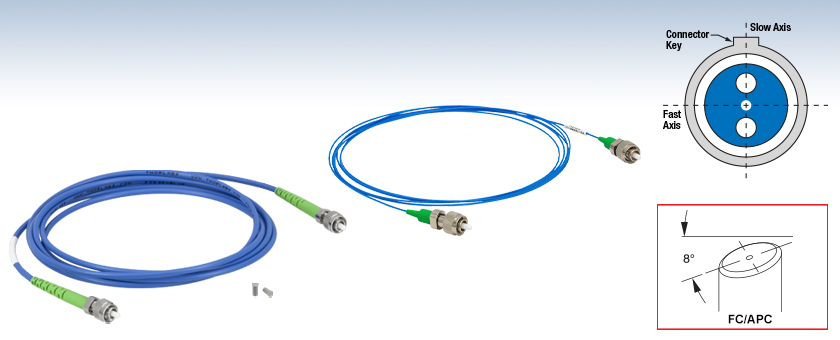
- Polarization-Maintaining Fiber with FC/APC Connectors on Both Ends
- Available in Wavelength Ranges between 350 - 2200 nm
- Custom Connector and Length Options Available
P3-1550PM-FC-2
1550 nm PM Patch Cable,
2 m Long, Ø3 mm Jacket
Connector Key Aligned to Slow Axis
P3-780PMY-2
780 nm PM Patch Cable,
2 m Long, Ø900 µm Jacket

Please Wait
| PM Fiber Patch Cable Selection Guide |
|---|
| FC/PC to FC/PC |
| FC/APC to FC/APC |
| FC/PC to FC/APC Hybrid |
| High-ER Cables FC/PC, FC/APC, and Hybrid |
| AR-Coated FC/PC and Hybrid |
| Dispersion-Compensating FC/APC |
| HR-Coated FC/PC and FC/APC |
Features
- Narrow Key (2.0 mm) Aligned to Slow Axis
- Typical Return Loss of 60 dB
- Ceramic 8° Angled Ferrules (APC)
- Ø900 µm or Ø3 mm Protective Outer Jacket
- Custom Patch Cables Available
These polarization-maintaining fiber optic patch cables are terminated on both ends with narrow key, ceramic-ferrule FC/APC connectors. Available from stock, these cables feature a high-quality polish, which leads to a typical return loss of 60 dB. Assembled in our facility, each cable is individually tested* at the test wavelength listed on the Specs tab to ensure its extinction ratio and insertion loss at fiber-to-fiber junctions. These measurements are available for individual patch cables by contacting Tech Support.
Each patch cable includes two protective caps that shield the ferrule ends from dust and other hazards. Additional CAPF Plastic Fiber Caps and CAPFM Metal Threaded Fiber Caps for FC/APC-terminated ends are also sold separately.
If you cannot find the appropriate stock patch cable your application requires, custom patch cables are available by clicking here. PM patch cables like the ones sold on this page are available in various lengths and tubing. Please contact Tech Support for more information.
*Please note that the port "A" mentioned in the inspection report refers to the end of the patch cable with a white label attached to it.
| Item # Prefix | P3-375PM-FC | P3-405BPM-FC | P3-488PM-FC | P3-630PMY | P3-630PM-FC | |
|---|---|---|---|---|---|---|
| Alignment Wavelength | 375 nm | 405 nm | 488 nm | 630 nm | ||
| Fiber Specs | ||||||
| Fiber Type | PM-S350-HP (PANDA) | PM-S405-XP (PANDA) | PM460-HP (PANDA) | PM630-HP (PANDA) | ||
| Operating Wavelength | 350 - 460 nm | 400 - 680 nm | 460 - 700 nm | 620 - 850 nm | ||
| Cutoff Wavelength | ≤340 nm | 380 ± 20 nm | 410 ± 40 nm | 570 ± 50 nm | ||
| Mode Field Diametera | 2.3 µm @ 350 nm | 3.3 ± 0.5 µm @ 405 nm 4.6 ± 0.5 µm @ 630 nm |
3.3 ± 0.5 µm @ 515 nm | 4.5 ± 0.5 µm @ 630 nm | ||
| Numerical Apertureb | 0.12 | 0.12 | 0.12 | 0.12 | ||
| Patch Cable Specs | ||||||
| Insertion Lossc,d | 1.50 dB (Max) 1.20 dB (Typ.) |
1.50 dB (Max) 1.20 dB (Typ.) |
1.50 dB (Max) 1.20 dB (Typ.) |
1.20 dB (Max) 1.00 dB (Typ.) |
||
| Extinction Ratioc,d | 15 dB (Min) 17 dB (Typ.) |
15 dB (Min) 17 dB (Typ.) |
18 dB (Min) 20 dB (Typ.) |
20 dB (Min) 22 db (Typ.) |
||
| Optical Return Lossc | 60 dB (Typical) | |||||
| Connector Type | FC/APC | |||||
| Key Width | 2.0 mm (Narrow Key) | |||||
| Slow Axis Alignment | Aligned to Connector Keye | |||||
| Cable Length | 1.0 m for Item Numbers Ending in -1 2.0 m for Item Numbers Ending in -2 5.0 m for Item Numbers Ending in -5 10.0 m for Item Numbers Ending in -10 |
|||||
| Cable Length Tolerance | +0.075 / -0 m | |||||
| Jacket Type | Ø3 mm Blue PVC Furcation Tubing |
Ø900 µm Blue Furcation Tubing |
Ø3 mm Blue PVC Furcation Tubing |
|||
| Operating Temperature | 0 to 70 °C | |||||
| Storage Temperature | -45 to 85 °C | |||||
| Item # Prefix | P3-780PMY | P3-780PM-FC | P3-980PMY | P3-980PM-FC | P3-1064PMY | P3-1064PM-FC |
|---|---|---|---|---|---|---|
| Alignment Wavelength | 780 nm | 980 nm | 1064 nm | |||
| Fiber Specs | ||||||
| Fiber Type | PM780-HP (PANDA) | PM980-XP (PANDA) | PM980-XP (PANDA) | |||
| Operating Wavelength | 770 - 1100 nm | 970 - 1550 nm | 970 - 1550 nm | |||
| Cutoff Wavelength | 710 ± 60 nm | 920 ± 50 nm | 920 ± 50 nm | |||
| Mode Field Diametera | 5.3 ± 1.0 µm @ 850 nm | 6.6 ± 0.5 µm @ 980 nm | 6.6 ± 0.5 µm @ 980 nm | |||
| Numerical Apertureb | 0.12 | 0.12 | 0.12 | |||
| Patch Cable Specs | ||||||
| Insertion Lossc,d | 1.00 dB (Max) 0.70 dB (Typ.) |
0.70 dB (Max) 0.50 dB (Typ.) |
0.70 dB (Max) 0.50 dB (Typ.) |
|||
| Extinction Ratioc,d | 20 dB (Min) 22 dB (Typ.) |
22 dB (Min) 24 dB (Typ.) |
22 dB (Min) 24 dB (Typ.) |
|||
| Optical Return Lossc | 60 dB (Typical) | |||||
| Connector Type | FC/APC | |||||
| Key Width | 2.0 mm (Narrow Key) | |||||
| Slow Axis Alignment | Aligned to Connector Keye | |||||
| Cable Length | 1.0 m for Item Numbers Ending in -1 2.0 m for Item Numbers Ending in -2 5.0 m for Item Numbers Ending in -5 10.0 m for Item Numbers Ending in -10 |
|||||
| Cable Length Tolerance | +0.075 / -0 m | |||||
| Jacket Type | Ø900 µm Blue Furcation Tubing |
Ø3 mm Blue PVC Furcation Tubing |
Ø900 µm Blue Furcation Tubing |
Ø3 mm Blue PVC Furcation Tubing |
Ø900 µm Blue Furcation Tubing |
Ø3 mm Blue PVC Furcation Tubing |
| Operating Temperature | 0 to 70 °C | |||||
| Storage Temperature | -45 to 85 °C | |||||
| Item # Prefix | P3-1310PMY | P3-1310PM-FC | P3-1550PMY | P3-1550PM-FC | P3-2000PM-FC | |
|---|---|---|---|---|---|---|
| Alignment Wavelength | 1310 nm | 1550 nm | 2000 nm | |||
| Fiber Specs | ||||||
| Fiber Type | PM1300-XP (PANDA) | PM1550-XP (PANDA) | PM2000 (PANDA) | |||
| Operating Wavelength | 1270 - 1625 nm | 1440 - 1625 nm | 1850 - 2200 nm | |||
| Cutoff Wavelength | 1210 ± 60 nm | 1380 ± 60 nm | 1720 ± 80 nm | |||
| Mode Field Diametera | 9.3 ± 0.5 µm @ 1300 nm | 10.1 ± 0.4 µm @ 1550 nm | 8.6 µm @ 1950 nm | |||
| Numerical Apertureb | 0.12 | 0.125 | 0.20 | |||
| Patch Cable Specs | ||||||
| Insertion Lossc,d | 0.50 dB (Max) 0.30 dB (Typ.) |
0.50 dB (Max) 0.30 dB (Typ.) |
0.50 dB (Max) 0.30 dB (Typ.) |
|||
| Extinction Ratioc,d | 23 dB (Min) 25 dB (Typ.) |
23 dB (Min) 25 dB (Typ.) |
23 dB (Min) 25 dB (Typ.) |
|||
| Optical Return Lossc | 60 dB (Typical) | |||||
| Connector Type | FC/APC | |||||
| Key Width | 2.0 mm (Narrow Key) | |||||
| Slow Axis Alignment | Aligned to Connector Keye | |||||
| Cable Length | 1.0 m for Item Numbers Ending in -1 2.0 m for Item Numbers Ending in -2 5.0 m for Item Numbers Ending in -5 10.0 m for Item Numbers Ending in -10 |
|||||
| Cable Length Tolerance | +0.075 / -0 m | |||||
| Jacket Type | Ø900 µm Blue Furcation Tubing |
Ø3 mm Blue PVC Furcation Tubing |
Ø900 µm Blue Furcation Tubing |
Ø3 mm Blue PVC Furcation Tubing |
Ø3 mm Blue PVC Furcation Tubing |
|
| Operating Temperature | 0 to 70 °C | |||||
| Storage Temperature | -45 to 85 °C | |||||
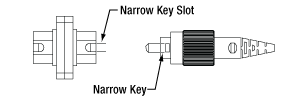
Click to Enlarge
Mating Between a Narrow-Key Mating Sleeve and Connector
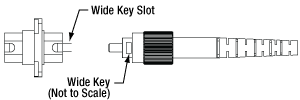
Click to Enlarge
Mating Between a Wide-Key Mating Sleeve and Connector
FC/PC and FC/APC Patch Cable Key Alignment
FC/PC and FC/APC Patch Cables are equipped with either a 2.0 mm narrow or 2.2 mm wide alignment key that fits into a corresponding slot on a mated component. These keys and slots are essential to correctly align the cores of connected fiber patch cables and minimize the insertion loss of the connection.
As an example, Thorlabs designs and manufactures mating sleeves for FC/PC- and FC/APC-terminated patch cables to precise specifications that ensure good alignment when used correctly. To ensure the best alignment, the alignment key on the patch cable is inserted into the corresponding narrow or wide-key slot on the mating sleeve.
Wide-Key-Slot Mating Sleeves
2.2 mm wide-key-slot mating sleeves are compatible with both wide-key and narrow-key connectors. However, using a narrow-key connector in a wide-key slot will allow the connector to rotate slightly in the mating sleeve (as shown in the animation below and to the left). While this configuration is acceptable for patch cables with FC/PC connectors, for FC/APC applications, we recommend using narrow-key-slot mating sleeves to ensure optimum alignment.
Narrow-Key-Slot Mating Sleeves
2.0 mm narrow-key-slot mating sleeves allow for optimal alignment of angled, narrow-key FC/APC connectors, as shown in the animation below and to the right. Therefore, they are not compatible with connectors that have a 2.2 mm wide key. Please note that all FC/PC and FC/APC patch cables manufactured by Thorlabs use narrow key connectors.
Once a narrow key connector is inserted into a narrow-key-slot mating sleeve, the connector will not rotate. We therefore recommend these mating sleeves for FC/PC and FC/APC connectors with narrow keys.
When a narrow key connector is inserted into a wide-key-slot mating sleeve, the connector has room to rotate. For narrow key FC/PC connectors, this is acceptable, but for narrow key FC/APC connectors, significant coupling losses will result.
| Quick Links |
|---|
| Damage at the Air / Glass Interface |
| Intrinsic Damage Threshold |
| Preparation and Handling of Optical Fibers |
Laser-Induced Damage in Silica Optical Fibers
The following tutorial details damage mechanisms relevant to unterminated (bare) fiber, terminated optical fiber, and other fiber components from laser light sources. These mechanisms include damage that occurs at the air / glass interface (when free-space coupling or when using connectors) and in the optical fiber itself. A fiber component, such as a bare fiber, patch cable, or fused coupler, may have multiple potential avenues for damage (e.g., connectors, fiber end faces, and the device itself). The maximum power that a fiber can handle will always be limited by the lowest limit of any of these damage mechanisms.
While the damage threshold can be estimated using scaling relations and general rules, absolute damage thresholds in optical fibers are very application dependent and user specific. Users can use this guide to estimate a safe power level that minimizes the risk of damage. Following all appropriate preparation and handling guidelines, users should be able to operate a fiber component up to the specified maximum power level; if no maximum is specified for a component, users should abide by the "practical safe level" described below for safe operation of the component. Factors that can reduce power handling and cause damage to a fiber component include, but are not limited to, misalignment during fiber coupling, contamination of the fiber end face, or imperfections in the fiber itself. For further discussion about an optical fiber’s power handling abilities for a specific application, please contact Thorlabs’ Tech Support.
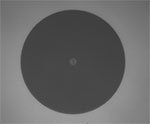
Click to Enlarge
Undamaged Fiber End
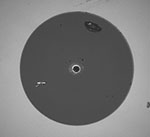
Click to Enlarge
Damaged Fiber End
Damage at the Air / Glass Interface
There are several potential damage mechanisms that can occur at the air / glass interface. Light is incident on this interface when free-space coupling or when two fibers are mated using optical connectors. High-intensity light can damage the end face leading to reduced power handling and permanent damage to the fiber. For fibers terminated with optical connectors where the connectors are fixed to the fiber ends using epoxy, the heat generated by high-intensity light can burn the epoxy and leave residues on the fiber facet directly in the beam path.
| Estimated Optical Power Densities on Air / Glass Interfacea | ||
|---|---|---|
| Type | Theoretical Damage Thresholdb | Practical Safe Levelc |
| CW (Average Power) |
~1 MW/cm2 | ~250 kW/cm2 |
| 10 ns Pulsed (Peak Power) |
~5 GW/cm2 | ~1 GW/cm2 |
Damage Mechanisms on the Bare Fiber End Face
Damage mechanisms on a fiber end face can be modeled similarly to bulk optics, and industry-standard damage thresholds for UV Fused Silica substrates can be applied to silica-based fiber. However, unlike bulk optics, the relevant surface areas and beam diameters involved at the air / glass interface of an optical fiber are very small, particularly for coupling into single mode (SM) fiber. therefore, for a given power density, the power incident on the fiber needs to be lower for a smaller beam diameter.
The table to the right lists two thresholds for optical power densities: a theoretical damage threshold and a "practical safe level". In general, the theoretical damage threshold represents the estimated maximum power density that can be incident on the fiber end face without risking damage with very good fiber end face and coupling conditions. The "practical safe level" power density represents minimal risk of fiber damage. Operating a fiber or component beyond the practical safe level is possible, but users must follow the appropriate handling instructions and verify performance at low powers prior to use.
Calculating the Effective Area for Single Mode Fibers
The effective area for single mode (SM) fiber is defined by the mode field diameter (MFD), which is the cross-sectional area through which light propagates in the fiber; this area includes the fiber core and also a portion of the cladding. To achieve good efficiency when coupling into a single mode fiber, the diameter of the input beam must match the MFD of the fiber.
As an example, SM400 single mode fiber has a mode field diameter (MFD) of ~Ø3 µm operating at 400 nm, while the MFD for SMF-28 Ultra single mode fiber operating at 1550 nm is Ø10.5 µm. The effective area for these fibers can be calculated as follows:
SM400 Fiber: Area = Pi x (MFD/2)2 = Pi x (1.5 µm)2 = 7.07 µm2 = 7.07 x 10-8 cm2
SMF-28 Ultra Fiber: Area = Pi x (MFD/2)2 = Pi x (5.25 µm)2 = 86.6 µm2 = 8.66 x 10-7 cm2
To estimate the power level that a fiber facet can handle, the power density is multiplied by the effective area. Please note that this calculation assumes a uniform intensity profile, but most laser beams exhibit a Gaussian-like shape within single mode fiber, resulting in a higher power density at the center of the beam compared to the edges. Therefore, these calculations will slightly overestimate the power corresponding to the damage threshold or the practical safe level. Using the estimated power densities assuming a CW light source, we can determine the corresponding power levels as:
SM400 Fiber: 7.07 x 10-8 cm2 x 1 MW/cm2 = 7.1 x 10-8 MW = 71 mW (Theoretical Damage Threshold)
7.07 x 10-8 cm2 x 250 kW/cm2 = 1.8 x 10-5 kW = 18 mW (Practical Safe Level)
SMF-28 Ultra Fiber: 8.66 x 10-7 cm2 x 1 MW/cm2 = 8.7 x 10-7 MW = 870 mW (Theoretical Damage Threshold)
8.66 x 10-7 cm2 x 250 kW/cm2 = 2.1 x 10-4 kW = 210 mW (Practical Safe Level)
Effective Area of Multimode Fibers
The effective area of a multimode (MM) fiber is defined by the core diameter, which is typically far larger than the MFD of an SM fiber. For optimal coupling, Thorlabs recommends focusing a beam to a spot roughly 70 - 80% of the core diameter. The larger effective area of MM fibers lowers the power density on the fiber end face, allowing higher optical powers (typically on the order of kilowatts) to be coupled into multimode fiber without damage.
Damage Mechanisms Related to Ferrule / Connector Termination
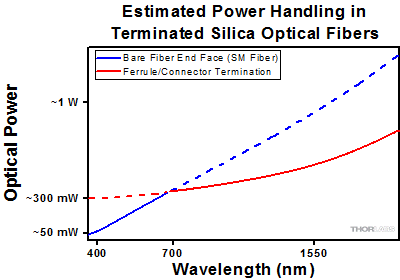 Click to Enlarge
Click to EnlargePlot showing approximate input power that can be incident on a single mode silica optical fiber with a termination. Each line shows the estimated power level due to a specific damage mechanism. The maximum power handling is limited by the lowest power level from all relevant damage mechanisms (indicated by a solid line).
Fibers terminated with optical connectors have additional power handling considerations. Fiber is typically terminated using epoxy to bond the fiber to a ceramic or steel ferrule. When light is coupled into the fiber through a connector, light that does not enter the core and propagate down the fiber is scattered into the outer layers of the fiber, into the ferrule, and the epoxy used to hold the fiber in the ferrule. If the light is intense enough, it can burn the epoxy, causing it to vaporize and deposit a residue on the face of the connector. This results in localized absorption sites on the fiber end face that reduce coupling efficiency and increase scattering, causing further damage.
For several reasons, epoxy-related damage is dependent on the wavelength. In general, light scatters more strongly at short wavelengths than at longer wavelengths. Misalignment when coupling is also more likely due to the small MFD of short-wavelength SM fiber that also produces more scattered light.
To minimize the risk of burning the epoxy, fiber connectors can be constructed to have an epoxy-free air gap between the optical fiber and ferrule near the fiber end face. Our high-power multimode fiber patch cables use connectors with this design feature.
Determining Power Handling with Multiple Damage Mechanisms
When fiber cables or components have multiple avenues for damage (e.g., fiber patch cables), the maximum power handling is always limited by the lowest damage threshold that is relevant to the fiber component. In general, this represents the highest input power that can be incident on the patch cable end face and not the coupled output power.
As an illustrative example, the graph to the right shows an estimate of the power handling limitations of a single mode fiber patch cable due to damage to the fiber end face and damage via an optical connector. The total input power handling of a terminated fiber at a given wavelength is limited by the lower of the two limitations at any given wavelength (indicated by the solid lines). A single mode fiber operating at around 488 nm is primarily limited by damage to the fiber end face (blue solid line), but fibers operating at 1550 nm are limited by damage to the optical connector (red solid line).
In the case of a multimode fiber, the effective mode area is defined by the core diameter, which is larger than the effective mode area for SM fiber. This results in a lower power density on the fiber end face and allows higher optical powers (on the order of kilowatts) to be coupled into the fiber without damage (not shown in graph). However, the damage limit of the ferrule / connector termination remains unchanged and as a result, the maximum power handling for a multimode fiber is limited by the ferrule and connector termination.
Please note that these are rough estimates of power levels where damage is very unlikely with proper handling and alignment procedures. It is worth noting that optical fibers are frequently used at power levels above those described here. However, these applications typically require expert users and testing at lower powers first to minimize risk of damage. Even still, optical fiber components should be considered a consumable lab supply if used at high power levels.
Intrinsic Damage Threshold
In addition to damage mechanisms at the air / glass interface, optical fibers also display power handling limitations due to damage mechanisms within the optical fiber itself. These limitations will affect all fiber components as they are intrinsic to the fiber itself. Two categories of damage within the fiber are damage from bend losses and damage from photodarkening.
Bend Losses
Bend losses occur when a fiber is bent to a point where light traveling in the core is incident on the core/cladding interface at an angle higher than the critical angle, making total internal reflection impossible. Under these circumstances, light escapes the fiber, often in a localized area. The light escaping the fiber typically has a high power density, which burns the fiber coating as well as any surrounding furcation tubing.
A special category of optical fiber, called double-clad fiber, can reduce the risk of bend-loss damage by allowing the fiber’s cladding (2nd layer) to also function as a waveguide in addition to the core. By making the critical angle of the cladding/coating interface higher than the critical angle of the core/clad interface, light that escapes the core is loosely confined within the cladding. It will then leak out over a distance of centimeters or meters instead of at one localized spot within the fiber, minimizing the risk of damage. Thorlabs manufactures and sells 0.22 NA double-clad multimode fiber, which boasts very high, megawatt range power handling.
Photodarkening
A second damage mechanism, called photodarkening or solarization, can occur in fibers used with ultraviolet or short-wavelength visible light, particularly those with germanium-doped cores. Fibers used at these wavelengths will experience increased attenuation over time. The mechanism that causes photodarkening is largely unknown, but several fiber designs have been developed to mitigate it. For example, fibers with a very low hydroxyl ion (OH) content have been found to resist photodarkening and using other dopants, such as fluorine, can also reduce photodarkening.
Even with the above strategies in place, all fibers eventually experience photodarkening when used with UV or short-wavelength light, and thus, fibers used at these wavelengths should be considered consumables.
Preparation and Handling of Optical Fibers
General Cleaning and Operation Guidelines
These general cleaning and operation guidelines are recommended for all fiber optic products. Users should still follow specific guidelines for an individual product as outlined in the support documentation or manual. Damage threshold calculations only apply when all appropriate cleaning and handling procedures are followed.
-
All light sources should be turned off prior to installing or integrating optical fibers (terminated or bare). This ensures that focused beams of light are not incident on fragile parts of the connector or fiber, which can possibly cause damage.
-
The power-handling capability of an optical fiber is directly linked to the quality of the fiber/connector end face. Always inspect the fiber end prior to connecting the fiber to an optical system. The fiber end face should be clean and clear of dirt and other contaminants that can cause scattering of coupled light. Bare fiber should be cleaved prior to use and users should inspect the fiber end to ensure a good quality cleave is achieved.
-
If an optical fiber is to be spliced into the optical system, users should first verify that the splice is of good quality at a low optical power prior to high-power use. Poor splice quality may increase light scattering at the splice interface, which can be a source of fiber damage.
-
Users should use low power when aligning the system and optimizing coupling; this minimizes exposure of other parts of the fiber (other than the core) to light. Damage from scattered light can occur if a high power beam is focused on the cladding, coating, or connector.
Tips for Using Fiber at Higher Optical Power
Optical fibers and fiber components should generally be operated within safe power level limits, but under ideal conditions (very good optical alignment and very clean optical end faces), the power handling of a fiber component may be increased. Users must verify the performance and stability of a fiber component within their system prior to increasing input or output power and follow all necessary safety and operation instructions. The tips below are useful suggestions when considering increasing optical power in an optical fiber or component.
-
Splicing a fiber component into a system using a fiber splicer can increase power handling as it minimizes possibility of air/fiber interface damage. Users should follow all appropriate guidelines to prepare and make a high-quality fiber splice. Poor splices can lead to scattering or regions of highly localized heat at the splice interface that can damage the fiber.
-
After connecting the fiber or component, the system should be tested and aligned using a light source at low power. The system power can be ramped up slowly to the desired output power while periodically verifying all components are properly aligned and that coupling efficiency is not changing with respect to optical launch power.
-
Bend losses that result from sharply bending a fiber can cause light to leak from the fiber in the stressed area. When operating at high power, the localized heating that can occur when a large amount of light escapes a small localized area (the stressed region) can damage the fiber. Avoid disturbing or accidently bending fibers during operation to minimize bend losses.
-
Users should always choose the appropriate optical fiber for a given application. For example, large-mode-area fibers are a good alternative to standard single mode fibers in high-power applications as they provide good beam quality with a larger MFD, decreasing the power density on the air/fiber interface.
-
Step-index silica single mode fibers are normally not used for ultraviolet light or high-peak-power pulsed applications due to the high spatial power densities associated with these applications.
| Posted Comments: | |
Jamil Mai
(posted 2024-07-18 11:52:42.86) Hi,
Do you have the dispersion related data for the PM fibers "P3-1550PM-FC-2"? jdelia
(posted 2024-07-18 02:11:16.0) Thank you for reaching out. I have contacted you directly via email to provide the requested data. user
(posted 2024-05-06 16:35:11.177) Do you have 45 degree PM cables? Are they any good? Can you please share their pros and cons? cdolbashian
(posted 2024-05-10 04:55:28.0) Thank you for reaching out to us with this inquiry. While we do not have these as part of our catalogue currently, we would love to hear from you regarding applications which would benefit from such a geometry. Alternatively, we can likely do this as a custom for you if you have the need for a particular application. As you have not left any contact information, we do look forward to hearing from you! user
(posted 2022-11-17 09:40:32.7) What's the maximum angle of incidence accepted by the 355nm fibers (375nm)? jgreschler
(posted 2022-11-17 02:19:15.0) Thank you for reaching out to Thorlabs. The fiber used in those cables is PM-S350-HP, which has an NA of 0.12. While we do not define our NA based off of acceptance angle, this corresponds roughly to a maximum half angle of 7 degrees. Jose Luis Cruz
(posted 2022-10-05 08:06:09.337) Could you please send a quote for the loose tube (0.9mm diameter) version of the patch cable
P3-1064PM-FC-2 ?
I will need two units.
Yours sincerely
Jose Luis. jgreschler
(posted 2022-10-13 03:58:39.0) Thank you for reaching out to Thorlabs. Custom configurations of stock items can be requested by contacting techsupport@thorlabs.com. I have reached out to you directly with details. Maria Romodina
(posted 2022-02-10 04:33:52.753) Could you please provide a beating length for 1300 nm for PM980-XP fiber? Does the speed difference of light along the fiber's fast and slow axes varies a lot for different wavelength inside the operating spectral range? jgreschler
(posted 2022-02-16 12:41:28.0) Thank you for reaching out to Thorlabs. The beat length is spec'd in the chart above the product listing. For PM980-XP it is <2.7mm at 980nm. Maria Romodina
(posted 2022-02-10 03:53:24.123) Dear sir or madame,
I want to by fiber PM1300-XP or PM980-XP. Could you please provide the difference between the light speed for slow and fast modes inside the fiber.
I want to calculate time delay between two orthogonal modes after propagation through the fiber.
Best wishes,
Maria jgreschler
(posted 2022-02-16 12:47:59.0) Thank you for reaching out to Thorlabs. The difference in the speed of light between slow and fast axes of the fiber will be ~1.35x10^6 for PM1300-XP and ~1.48x10^6 for PM980-XP. Gregor A.
(posted 2021-03-20 08:11:55.85) Dear Thorlabs,
what is the minimum (recommended) bending radius for these fibers to prevent damage and/or excessive loss?
Thanks,
Gregor YLohia
(posted 2021-03-29 02:43:18.0) Hello Gregor, please see the minimum bend radius (13 mm) for the component fiber (PM-S405-XP) used in the P3-405BPM-FC-2 here: https://www.thorlabs.com/newgrouppage9.cfm?objectgroup_id=1596&pn=PM-S405-XP robert supe
(posted 2021-03-04 16:40:05.373) It would be great if you offered these in FC/PC to FC/APC. If you do they are impossible to find on your website. YLohia
(posted 2021-03-05 09:52:21.0) Our polarization maintaining FC/PC to FC/APC are listed on this page: https://www.thorlabs.com/newgrouppage9.cfm?objectgroup_id=3882 (Polarization-Maintaining Hybrid Fiber Optic Patch Cables). The part number you're specifically looking for is P5-1310PM-FC-2. Edge Briscoe
(posted 2020-06-02 11:00:34.327) The photo is not of an FC/APC patch cord, it is a FC/PC patch cord.
Am I missing something? YLohia
(posted 2020-06-02 11:44:56.0) Thank you for your feedback. The picture for the P3-1064PM-FC-1 is indeed not FC/APC. The item is FC/APC, but the picture is incorrect. We will fix this. user
(posted 2019-08-22 13:07:28.087) Hello, what is expected Extinction Ratio for the 50 meters of PM780-HP fiber? Thanks. nbayconich
(posted 2019-08-22 04:11:29.0) Thank you for contacting Thorlabs. It is difficult to specify an exact extinction ratio of longer PM fiber patch cables such as 50 meter cables. I will reach out to you directly. Woojae Kang
(posted 2019-05-10 13:29:43.727) Dear officer of Thorlabs,
My name is Woojae and I am a graduate student of KAIST, South Korea.
I want a "dispersion vs wavelength" plot of PM 980 xp patch cable.
Please contact me via my e mail above.
Thanks,
Best,
Woojae Kang YLohia
(posted 2019-05-13 09:55:23.0) Hello Woojae, thank you for contacting Thorlabs. I have reached out to you directly with this information. The dispersion curves for these fibers can be requested by emailing us at techsupport@thorlabs.com. akg
(posted 2018-09-18 01:49:56.69) Hello,
My operating wavelength is 1550nm. Which Polarization Maintaining Fiber (PM1330XP or PM1550XP or some other one) is best suited for interfacing with Standard Single Mode Fiber. Please suggest which connector is best for this purpose and the part which can be used for mating the two (PMF connector with SSMF connector)? YLohia
(posted 2018-09-18 08:32:11.0) Hello, looking at your other requests, the PM1550-XP is recommended since that is used in the connections for the MX series of modulators. The connector on this fiber should match that of your single mode fiber. You would have to use the ADAFCPM2 connector for PM APC mating. user
(posted 2018-08-15 20:18:11.963) Hello, is the damage threshold shown or calculated the power before couping or the power that coupled into the fiber? For example, if the damage threshold is considered to be 300mW and the coupling efficiency is 30%, the maximum power we can use before the collimator is 300mW or 1W? YLohia
(posted 2018-08-16 08:58:25.0) Hello, thank you for contacting Thorlabs. This damage threshold is for the maximum amount of power that can be sent into the fiber. It does not mean that you can send in 1 W if the coupling efficiency is 30%. user
(posted 2018-06-27 14:06:21.087) Hello, what is the thermal coefficient of delay for the PM1550 nm fiber? YLohia
(posted 2018-06-27 09:33:00.0) Hello, thank you for contacting Thorlabs. Unfortunately, we do not have this information for our fibers. That being said, it should be standard for Ge-doped fused silica since that is what the core is made of. jens.kiessling
(posted 2018-06-05 12:37:09.31) Dear Thorlabs team,
is it possible to connect your PM1550nm fiber to a SM fiber like your 1550BHP or SMF28 fiber using FC/APC connectors? Can you estimate the losses? Of course the direction would be PM->SM
thanks in advance
Jens YLohia
(posted 2018-06-05 11:04:28.0) Hello Jens, you could use our ADAFC3 FC/APC to FC/APC mating sleeve to connect your two APC connectorized fibers together. The insertion loss is specified to be <0.5 dB (Measured at 635 nm with FC-Terminated SM600 Fibers). martin.ibruegger
(posted 2017-07-14 16:52:01.133) Hello, is it possible to get such a PM patch cable for a wavelength of 354nm? tfrisch
(posted 2017-08-07 01:58:18.0) Hello, thank you for contacting Thorlabs. We can make custom patch cables using PM-S350-HP. I will reach out to you directly. https://www.thorlabs.com/newgrouppage9.cfm?objectgroup_id=2410 kruchy181
(posted 2017-04-28 12:32:03.97) Hello, I would like to ask what value of DGD (approximately) I can measure using your P3-1550PM-FC-2 patch cable? nbayconich
(posted 2017-05-22 10:20:51.0) Thank you for contacting Thorlabs. The approximated DGD (Differential Group Delay) of the P3-1550PM-FC-2 is 7.11 x 10-13 s/√km. A Thorlabs techsupport representative will reach out to you directly. adrianvallejo
(posted 2017-03-29 21:31:52.517) Hello I would like to know an alignment technique for preserves polarization into P3-1550PM-FC-2 fibers.
Cheers tfrisch
(posted 2017-03-31 04:27:51.0) Hello, thank you for contacting Thorlabs. For a PM fiber to preserve a polarization state, that state must be linear and aligned to the slow axis of the fiber (which is typically the axis aligned to the FC/PC or FC/APC key). Otherwise, if the light is launched into the fiber with a component in the fast and slow axis, the PM fiber will effectively act as a waveplate of very high arbitrary order. I will reach out to you directly to discuss the operation. user
(posted 2016-04-08 14:47:35.167) If I need one of these for 767nm, should I get the one centred at 630nm or is the 780nm ok? I can't find anything that indicates the performance difference of the two at this wavelength. jlow
(posted 2016-04-08 04:13:11.0) Response from Jeremy at Thorlabs: For 767nm, you will want to use the one with 630nm. The 780nm version would not be single mode at 767nm. alexia.ravaille
(posted 2016-03-16 14:51:41.973) I would like to know more about the "Optical Return Loss" : What is measured to get this coefficient of 60 dB? Does it have something to do with Rayleigh Backscattering ? besembeson
(posted 2016-03-17 09:16:25.0) Response from Bweh at Thorlabs USA: No. That specifies the amount of Fresnel reflections (due to the index change between fiber and air) that go back towards the input. The FC/APC connector is designed to have an 8 degree angle so that all reflections are sent back outside of the fiber's acceptance angle to ensure very low reflections. Rayleigh backscattering will typically be upwards of -110dB and there are other established techniques of measuring this such as an Optical Backscatter Reflectometer system. rupak
(posted 2015-09-03 15:16:24.627) Can you get a data sheet for this product myanakas
(posted 2015-09-04 09:18:28.0) Response from Mike at Thorlabs: Thank you for your feedback. An individual data sheet is shipped with each patch cable. Complete specifications can be found on our website on the "Specs" tab here: http://www.thorlabs.com/newgrouppage9.cfm?objectgroup_id=3345&tabname=Specs as well as in our PDF drawing found by clicking on the red "Docs" Icon next to the item number. josh.atkinson
(posted 2014-05-21 13:02:16.703) Can this be made available in longer lengths, 30M? Will the extinction ration specification change with longer length? How well can one expect the polarization to be maintained over a 30M length? pbui
(posted 2014-06-04 10:35:41.0) Yes, we are able to offer custom cables made to 30m lengths. For custom length cables with lengths comparable to our catalog offerings, we should be able to meet similar specs for extinction ratio (ER) and insertion loss. However, it's important to note that ER is length dependent and will deteriorate with increasing length. For cables longer than our catalog offerings, which is 10m at a maximum, we are able to unable to guarantee the ER spec. user
(posted 2013-09-12 02:25:57.12) Would it be possible to have fiber patch cables like this but for 1030nm on stock? jlow
(posted 2013-09-12 16:09:00.0) Response from Jeremy at Thorlabs: The P3-1064PM-FC-1 fiber can be used at 1030nm as well. skyzeus
(posted 2013-04-09 14:10:41.66) I would like to ask that whether two fiber connected with a FC/APC connector can aligned to the slow axis?
Was the inserted pin fixed the angle of the fiber end face as well as the slow axis?
Thanks! jlow
(posted 2013-04-09 16:30:00.0) Response from Jeremy at Thorlabs: The connector key is aligned to the slow axis for our stocked PM patch cables. tcohen
(posted 2012-08-15 10:15:00.0) Response from Tim at Thorlabs: The P3-488PM-FC-2 uses PM460-HP fiber. The MFD of this fiber is approximately 3.3 +/- 0.5 microns at 515 nm. When we look at the damage threshold of a fiber there are many considerations to take into account. The first is connectorization. The connectors here will already limit the damage threshold to a couple of Watts. Furthermore, we look at a general limit of silica at approximately 10mW/um^2. We see that 80% of the MFD is ~2.64um. Therefore, we would expect a working radius of ~1.32um. This would equate to ~54.7mW. Of course this is a theoretical approximation. Actual lab conditions will depend on where the incident light is focused (ie: high coupling efficiency?), how clean the fiber tip is, what the wavelength is, etc. I will contact you so that we can continue this conversation. steven.king
(posted 2012-08-15 15:21:28.0) What is the damage threshold for the P3-488PM-FC-2? tcohen
(posted 2012-05-01 13:39:00.0) Response from Tim at Thorlabs: Thank you for your feedback! We do offer our Air-Spaced Doublet Collimators in a 2um APC compatible version: the F810APC-2000. We are also looking to expand our optics and our Fixed Fiber Optic Collimation Packages to include a 2um APC version in the near future. g9622513
(posted 2012-05-01 03:03:46.0) Do you supply the suitable fiber collimator for 2000 nm PM FC/APC Patch Cable? bdada
(posted 2011-10-25 13:13:00.0) Response from Buki at Thorlabs:
Thank you for your feedback. Yes, ER will decrease with long lengths of fiber but 2-5m is negligible. In general the longer wavelengths will see less change in PER for the same length of fiber. The physical environment will have more of an impact on PER than the length. Please contact TechSupport@thorlabs.com if you have further questions about this. user
(posted 2011-10-25 12:19:22.0) How come the extinction ratio is 20dB for both 2m and 5m? Shouldn't the E.R. get lower with fiber length? philip.starkey
(posted 2010-10-12 14:14:04.0) Hi, can someone let me know what the damage threshold of the fibre/cladding is for the P3-780PM-FC-5? As in, if I put 1W into a 70% efficient fibre couple, Ill have 300mW leaking into the cladding. Will this damage the fibre or FC/APC connector? user
(posted 2009-03-28 15:47:34.0) I checked a few sources and found that blue is the defacto standard, so while it is not a fully ratified international standard it does seem reasonable for Thorlabs to join in making it one. I will ask for this change to be implement as quickly as possible... Alex Cable Greg
(posted 2009-03-27 15:54:02.0) A response from Greg at Thorlabs to brian.wojo: Thank you for your feedback regarding our PM cables. There isnt a standard for PM cables, but it is not uncommon to see blue tubing used. We are actually working on providing blue furcation tubing to our lineup for PM cables. This should be available shortly. brian.wojo
(posted 2009-03-27 12:28:31.0) Im not sure if things have changed, byt for the past 15 years the industry standard for jacketing color coding is Orange for MM fiber, Yellow for standard SM fiber, and blue for PM fiber. Why do you not offer blue jacketing? This is very confusing to determine the fiber type without having a spec sheet in front of you. This potentially can cause our end-users endless confusion. |

| Item # | Alignment Wavelength |
Fiber Type | Operating Wavelength |
Cutoff Wavelength |
Extinction Ratioa |
Insertion Lossa |
Mode Field Diameterb |
Jacket | Length |
|---|---|---|---|---|---|---|---|---|---|
| P3-375PM-FC-1 | 375 nm | PM-S350-HP (PANDA) |
350 - 460 nm | ≤340 nm | 15 dB (Min) 17 dB (Typ.) |
1.50 dB (Max) 1.20 dB (Typ.) |
2.3 µm @ 350 nm | Ø3 mm Blue PVC Furcation Tubing |
1 m |
| P3-375PM-FC-2 | 2 m | ||||||||
| P3-375PM-FC-5 | 5 m | ||||||||
| P3-375PM-FC-10 | 10 m |

| Item # | Alignment Wavelength |
Fiber Type | Operating Wavelength |
Cutoff Wavelength |
Extinction Ratioa |
Insertion Lossa |
Mode Field Diameterb | Jacket | Length |
|---|---|---|---|---|---|---|---|---|---|
| P3-405BPM-FC-1 | 405 nm | PM-S405-XP (PANDA) |
400 - 680 nm | 380 ± 20 nm | 15 dB (Min) 17 dB (Typ.) |
1.50 dB (Max) 1.20 dB (Typ.) |
3.3 ± 0.5 µm @ 405 nm 4.6 ± 0.5 µm @ 630 nm |
Ø3 mm Blue PVC Furcation Tubing |
1 m |
| P3-405BPM-FC-2 | 2 m | ||||||||
| P3-405BPM-FC-5 | 5 m | ||||||||
| P3-405BPM-FC-10 | 10 m |

| Item # | Alignment Wavelength |
Fiber Type | Operating Wavelength |
Cutoff Wavelength |
Extinction Ratioa |
Insertion Lossa |
Mode Field Diameterb | Jacket | Length |
|---|---|---|---|---|---|---|---|---|---|
| P3-488PM-FC-1 | 488 nm | PM460-HP (PANDA) |
460 - 700 nm | 410 ± 40 nm | 18 dB (Min) 20 dB (Typ.) |
1.50 dB (Max) 1.20 dB (Typ.) |
3.3 ± 0.5 µm @ 515 nm | Ø3 mm Blue PVC Furcation Tubing |
1 m |
| P3-488PM-FC-2 | 2 m | ||||||||
| P3-488PM-FC-5 | 5 m | ||||||||
| P3-488PM-FC-10 | 10 m |

| Item # | Alignment Wavelength |
Fiber Type | Operating Wavelength |
Cutoff Wavelength |
Extinction Ratioa |
Insertion Lossa |
Mode Field Diameterb | Jacket | Length |
|---|---|---|---|---|---|---|---|---|---|
| P3-630PMY-1 | 630 nm | PM630-HP (PANDA) |
620 - 850 nm | 570 ± 50 nm | 20 dB (Min) 22 dB (Typ.) |
1.20 dB (Max) 1.00 dB (Typ.) |
4.5 ± 0.5 µm @ 630 nm | Ø900 µm Blue Furcation Tubing |
1 m |
| P3-630PMY-2 | 2 m | ||||||||
| P3-630PM-FC-1 | Ø3 mm Blue PVC Furcation Tubing |
1 m | |||||||
| P3-630PM-FC-2 | 2 m | ||||||||
| P3-630PM-FC-5 | 5 m | ||||||||
| P3-630PM-FC-10 | 10 m |

| Item # | Alignment Wavelength |
Fiber Type | Operating Wavelength |
Cutoff Wavelength |
Extinction Ratioa |
Insertion Lossa |
Mode Field Diameterb | Jacket | Length |
|---|---|---|---|---|---|---|---|---|---|
| P3-780PMY-1 | 780 nm | PM780-HP (PANDA) |
770 - 1100 nm | 710 ± 60 nm | 20 dB (Min) 22 dB (Typ.) |
1.00 dB (Max) 0.70 dB (Typ.) |
5.3 ± 1.0 µm @ 850 nm | Ø900 µm Blue Furcation Tubing |
1 m |
| P3-780PMY-2 | 2 m | ||||||||
| P3-780PM-FC-1 | Ø3 mm Blue PVC Furcation Tubing |
1 m | |||||||
| P3-780PM-FC-2 | 2 m | ||||||||
| P3-780PM-FC-5 | 5 m | ||||||||
| P3-780PM-FC-10 | 10 m |

| Item # | Alignment Wavelength |
Fiber Type | Operating Wavelength |
Cutoff Wavelength |
Extinction Ratioa,b |
Insertion Lossb |
Mode Field Diameterc | Jacket | Length |
|---|---|---|---|---|---|---|---|---|---|
| P3-980PMY-1 | 980 nm | PM980-XP (PANDA) |
970 - 1550 nm | 920 ± 50 nm | 22 dB (Min) 24 dB (Typ.) |
0.70 dB (Max) 0.50 dB (Typ.) |
6.6 ± 0.5 µm @ 980 nm | Ø900 µm Blue Furcation Tubing |
1 m |
| P3-980PMY-2 | 2 m | ||||||||
| P3-980PM-FC-1 | Ø3 mm Blue PVC Furcation Tubing |
1 m | |||||||
| P3-980PM-FC-2 | 2 m | ||||||||
| P3-980PM-FC-5 | 5 m | ||||||||
| P3-980PM-FC-10 | 10 m |

| Item # | Alignment Wavelength |
Fiber Type | Operating Wavelength |
Cutoff Wavelength |
Extinction Ratioa,b |
Insertion Lossb |
Mode Field Diameterc | Jacket | Length |
|---|---|---|---|---|---|---|---|---|---|
| P3-1064PMY-1 | 1064 nm | PM980-XP (PANDA) |
970 - 1550 nm | 920 ± 50 nm | 22 dB (Min) 24 dB (Typ.) |
0.70 dB (Max) 0.50 dB (Typ.) |
6.6 ± 0.5 µm @ 980 nm | Ø900 µm Blue Furcation Tubing |
1 m |
| P3-1064PMY-2 | 2 m | ||||||||
| P3-1064PM-FC-1 | Ø3 mm Blue PVC Furcation Tubing |
1 m | |||||||
| P3-1064PM-FC-2 | 2 m | ||||||||
| P3-1064PM-FC-5 | 5 m | ||||||||
| P3-1064PM-FC-10 | 10 m |

| Item # | Alignment Wavelength |
Fiber Type | Operating Wavelength |
Cutoff Wavelength |
Extinction Ratioa,b |
Insertion Lossb |
Mode Field Diameterc | Jacket | Length |
|---|---|---|---|---|---|---|---|---|---|
| P3-1310PMY-1 | 1310 nm | PM1300-XP (PANDA) |
1270 - 1625 nm | 1210 ± 60 nm | 23 dB (Min) 25 dB (Typ.) |
0.50 dB (Max) 0.30 dB (Typ.) |
9.3 ± 0.5 µm @ 1300 nm | Ø900 µm Blue Furcation Tubing |
1 m |
| P3-1310PMY-2 | 2 m | ||||||||
| P3-1310PM-FC-1 | Ø3 mm Blue PVC Furcation Tubing |
1 m | |||||||
| P3-1310PM-FC-2 | 2 m | ||||||||
| P3-1310PM-FC-5 | 5 m | ||||||||
| P3-1310PM-FC-10 | 10 m |

| Item # | Alignment Wavelength |
Fiber Type | Operating Wavelength |
Cutoff Wavelength |
Extinction Ratioa,b |
Insertion Lossb |
Mode Field Diameterc | Jacket | Length |
|---|---|---|---|---|---|---|---|---|---|
| P3-1550PMY-1 | 1550 nm | PM1550-XP (PANDA) |
1440 - 1625 nm | 1380 ± 60 nm | 23 dB (Min) 25 dB (Typ.) |
0.50 dB (Max) 0.30 dB (Typ.) |
10.1 ± 0.4 µm @ 1550 nm | Ø900 µm Blue Furcation Tubing |
1 m |
| P3-1550PMY-2 | 2 m | ||||||||
| P3-1550PM-FC-1 | Ø3 mm Blue PVC Furcation Tubing |
1 m | |||||||
| P3-1550PM-FC-2 | 2 m | ||||||||
| P3-1550PM-FC-5 | 5 m | ||||||||
| P3-1550PM-FC-10 | 10 m |

| Item # | Alignment Wavelength |
Fiber Type | Operating Wavelength |
Cutoff Wavelength |
Extinction Ratioa |
Insertion Lossa |
Mode Field Diameterb |
Jacket | Length |
|---|---|---|---|---|---|---|---|---|---|
| P3-2000PM-FC-1 | 2000 nm | PM2000 (PANDA) |
1850 - 2200 nm | 1720 ± 80 nm | 23 dB (Min) 25 dB (Typ.) |
0.50 dB (Max) 0.30 dB (Typ.) |
8.0 µm @ 1950 nm | Ø3 mm Blue PVC Furcation Tubing |
1 m |
| P3-2000PM-FC-2 | 2 m |
 Products Home
Products Home


















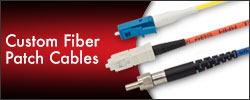
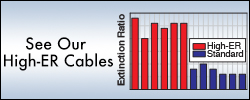
 PM FC/APC Patch Cables
PM FC/APC Patch Cables